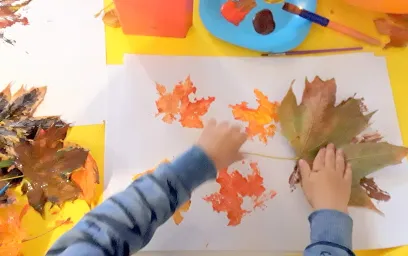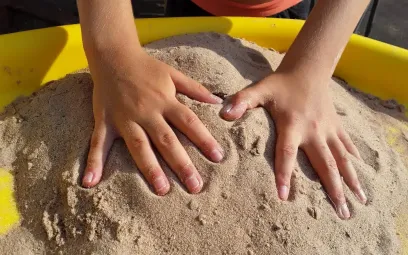Art in Nature Activities
Within key stage one our Art in Nature topic covers points of the national curriculum for England in: Art, Music and Science. This core topic contains seven activities, plus activity sheets and activity related videos. Your child or classroom will delight at the inspiration they find exploring the natural world around them.
Life art does not require a lot of materials, year two children can paint using leaves, sticks and other items from nature. By using their natural environment pupils will find examples to develop their natural relationship with nature. Get your students outdoors to explore the colours of art in nature. Inspire exhibitions of natural life by taking pictures, playing music and making land art.
Land Art Activities
During this art in nature activity, your child will not only learn about how artists such as Tove Jansson use natural materials in their artwork, but students will also develop their observation skills by closely examining the shape, pattern, and texture of different nature items. Additionally, being in nature can have a calming effect on children and can promote mindfulness and creativity.
Creating clay moulds of nature items is a fun and educational activity that can help your child develop several important skills. By closely observing the shapes, patterns, and textures of different objects found in nature, your child can learn to appreciate the beauty and complexity of the natural world.
Some possible prompt questions that your child can use to guide their thinking and discussions while creating their artwork include:
- What shapes and patterns do you see in the natural materials you've collected?
- How can you arrange these materials to create a visually interesting composition?
- What emotions or ideas do these materials evoke?
- How can you use colour to enhance your artwork?
- What message or story are you trying to convey through your artwork?
Encourage your child to experiment with different arrangements of the natural materials and to let their creativity guide them. Remind them that there is no right or wrong way to create art and that the most important thing is to have fun and express their vision of the natural world around them.
Photography in Nature
If you're looking for a fun activity to do with your child, photography in nature is a great option. Not only does it encourage students to explore the outdoors, but it also allows them to express their creativity.
Encourage your child to take pictures of anything that catches their eye, whether it's a flower, a bird, or a rock. Take the opportunity to discuss with your child what they find interesting about the things they're photographing. Consider visiting an art gallery dedicated to photography. Use our Photography in Nature Activity Sheet to spark conversation and prompt your child to think more deeply about the photographs they've taken. The questions can also help pupils practice their descriptive skills and expand their vocabulary.
Remember, the goal of this activity is to have fun and encourage your child's curiosity about the natural world around them. So, grab a camera, get to a special exhibition or let your students create their own!
Colours in Nature
This enjoyable activity can be conducted throughout the year to record the changes in nature's colours as the seasons shift. Find a local museum to give birth to new ideas of colour and its importance in observing nature.
To ensure your child or students have ample opportunity to see a range of colours, plan a nature walk and let their creative juices flow with this year two activity. Be sure to print out the Colour Hunt Activity Sheet material which your child can use to tick off the colours they see or create their own colour chart.
Leaf Printing
Leaf printing is a wonderful way to get your child or pupil interested in nature and art. Here are some tips and ideas for our leaf printing activity.
Encourage your child to explore different types of leaves and collect examples. Wildlife will offer us a great variety of different shapes, sizes, and textures which can be turned into artwork or even sculptures.
Home educators and teachers can discuss the different patterns and shapes they can use while making their original artwork or sculpture. Ask your young artist to describe what they see and what they like about each arrangement.
If your creative artist is having trouble getting started, you can suggest some basic shapes or patterns to try, such as a circle or a line of leaves. They can use markers, paint, or even natural materials like dirt or sand to add depth and dimension to their artwork.
After your child has finished their leaf prints, why not hold a special exhibit in your classroom or home. Visiting a local museum is also always a great way to gain exposure to existing art in nature.
Clay Moulds
Creating clay moulds of nature items is a fun and educational activity that can help your child develop several important skills. By closely observing the shapes, patterns, and textures of different objects found in nature, your child can learn to appreciate the beauty and complexity of the natural world. Additionally, working with clay can help improve your child's fine motor skills and hand-eye coordination.
To get started, encourage your child to explore their surroundings and look for interesting objects to use for their moulds. They might find leaves, flowers, or even small rocks that they want to use. Once they have collected their materials, they can begin making their moulds using the clay and following the instructions provided in the Clay Mould Evaluation worksheet.
After your child has finished making their moulds, it's important to take time to discuss their ideas and evaluate their artwork. The evaluation template provided in the Clay Mould Evaluation worksheet can be a helpful tool for guiding this discussion. Encourage your artist to share their thoughts and feelings about their artwork, as well as any challenges they faced during the process. This can help them develop critical thinking skills and learn to express themselves creatively.
Drawing And Painting in Nature
Hands-On Educations love creating activities that explore the seasonal changes in nature. Encourage your primary aged students to use all their senses to explore nature, including touching, smelling, and listening to the sounds around them.
If possible, take your year two students to different locations, such as a nearby park or beach, to observe nature and its seasonal changes. Help them learn more about the different types of trees, flowers, insects, birds and animals they come across.
Consider having your students keep a nature journal where they can draw or write about their observations and discoveries. Each season is an opportunity to teach the importance of conservation and how we can protect and care for our environment.
Music In Nature
In this activity you can encourage your pupil’s musical curiosity through nature exploration and instrument-making. Pupils in this activity have the opportunity to discover the sounds of in nature and create musical instruments using natural materials found outdoors. As you guide your pupil through this fun and educational experience, it may be helpful to become familiar with the "interrelated dimensions of music" outlined in the national curriculum, including Pitch, Dynamics, Tempo, Rhythm, Texture, Melody, Harmony, Structure, and Timbre. While not all of these concepts need to be incorporated into this activity, understanding these terms will help you facilitate meaningful discussions about music and sound with your pupils.
Natural World Inspiration
Art and beauty can be found everywhere once one’s awareness of the earths landscapes and wildlife come into focus. Art in nature can be a wonderfully diverse canvas of possibilities from drawing locomotives to recording the elements such as a New Mexico thunder storm or budding flowers.
Visiting art galleries and museums can make for a great day out. Art can often take on a dark twist, especially in modern sculptures. Environmental issues your child may be learning about in school are often displayed in contemporary art. Disquieting stories can be told through portraits and life scenes of fine art. Galleries are as varied as the art they house, find one that speaks to both you and your child.
Animals and wildlife often feature in art in nature. Our world is so full of original artwork that anyone saying they don’t like painting, sculpture or exhibitions in general have simply not found artists that speak to them yet. There is a world of buried treasure called art. Discover large outdoor expeditions if you feel housed artwork is not for you or your children.
Types of Artworks
The global art market is huge and widely variety. Abstract artist such as Wassily Kandinsky, Jackson Pollock and Piet Mondrian have widely different styles. Impressionists such as Camille Pissarro, Edgar Degas and Claude Monet changed the landscape of art forever with their own ambivalence to the prevailing norm in the mid-1800s.
Renegade love stories and relationships are portrayed by artists such as Tove Jansson. Tove Jansson was a versatile, artistic talent characterized by her narrative device and sense of colour for which she was able to tell many disquieting stores. Painting has the power to insure one’s own sanity and awaken one’s awareness in some cases averting an artist’s impending nervous breakdown.






















